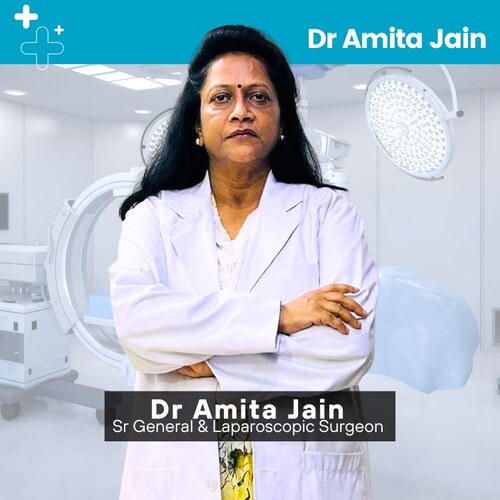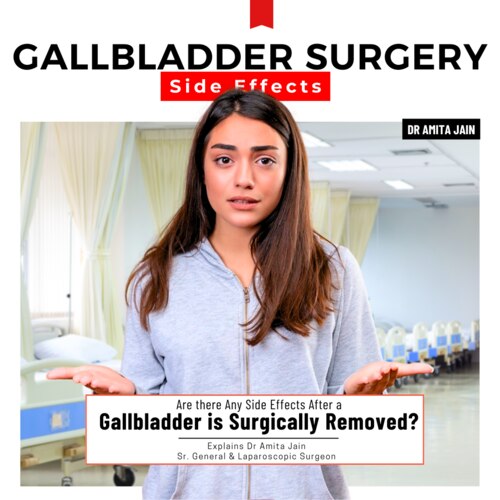If you’re preparing for gallbladder removal surgery because of gallstones, know that you’re definitely not alone. Around 20 million people deal with gallstones, and each year, about 300,000 go on to have their gallbladder removed. That’s a lot of people choosing to finally get relief from the pain and discomfort.
This surgery, officially called a cholecystectomy, can be life-changing in the best way, especially if you’ve been living with cramping, nausea, or unpredictable digestive issues. But it’s normal to wonder: What will life be like without a gallbladder? Are there side effects? Will your digestion change?
Let’s discuss what you might experience after surgery and how to care for your body as it adjusts, based on insights shared by Dr Amita Jain, India’s top general and laparoscopic surgeon specialist for gallbladder removal surgery.
What Changes After Your Gallbladder Is Removed?
Your gallbladder acts as a storage unit for bile, a digestive fluid your liver produces to help break down fats. When the gallbladder is removed, your liver still makes bile—it just doesn’t get stored anymore. Instead, bile flows directly into your small intestine. This shift is natural, but it can cause some changes in your digestion, especially early on. Here are a few things you might notice:
1. Loose Stools or Diarrhoea – Some people experience more frequent or looser bowel movements after surgery. That’s because the constant flow of bile into the intestines can sometimes speed things up. Thankfully, this is usually temporary. Eating low-fat, bland foods and avoiding greasy meals can really help ease things during this adjustment period.
2. Bloating and Gas – Feeling a bit gassy or bloated after meals is another common post-surgery symptom. Again, it’s often tied to how your body is relearning to process fats. Eating smaller portions and spacing out meals during the day can help keep your gut more comfortable.
3. Trouble Digesting Fats – Without the gallbladder to release bile in doses, your body may not break down fatty foods as efficiently at first. You don’t need to cut out fats completely—just go easy. Choose healthy fats like avocado, olive oil, or nuts, and avoid heavy, fried foods while your digestion finds its new rhythm.
Managing Long-Term Digestion Without a Gallbladder
Most people adjust well within a few weeks or months. But if you find yourself still dealing with symptoms, there are simple lifestyle tweaks that can help.
Add Fibre Slowly – Fibre is great for digestion, but adding too much too fast can actually cause more gas or bloating. Start slow with foods like bananas, oats, and apples. Over time, this helps firm up stools and keep your digestion steady.
Vegetable-based fibre is especially helpful—it supports your gut lining, slows down digestion just enough, and reduces your chances of diarrhoea.
Identify and Avoid Trigger Foods – Spicy curries, greasy takeout, and overly processed snacks may no longer sit well with your stomach. Try keeping a food diary to track what causes discomfort, and steer clear of those foods for a while.
Stay Hydrated – This one’s simple but powerful. Water helps your body digest food, absorb nutrients, and replace any fluids lost due to diarrhoea. Keep sipping throughout the day to stay on track.
When to Reach Out for Help
Having your gallbladder removed is a significant decision—one that’s usually only made after other treatments didn’t work. While many people feel better pretty quickly, don’t ignore lingering digestive issues.
In some rare cases, bile acid diarrhoea (BAD) can develop, where bile irritates the intestines and causes ongoing problems. If that happens, talk to your doctor. There are medications and treatments that can help manage bile flow and reduce symptoms.
Life after gallbladder removal does come with some changes, but it also brings a lot of relief. For most, the benefits far outweigh the temporary digestive ups and downs. Be patient with your body, stay mindful of what you eat, and don’t hesitate to ask for help if something feels off.
In time, your digestion will find its balance, and you’ll finally be free from the symptoms that led you here in the first place.

Dr Amita Jain is one of India’s most distinguished and experienced female surgeons, known for her unmatched expertise in general and laparoscopic surgery. With over 29 years of surgical excellence, Dr Amita Jain has built a reputation for precision, compassionate care, and advanced surgical techniques.
Dr Amita Jain has successfully performed a wide range of complex general surgeries, including both open and minimally invasive procedures, with a strong focus on trauma care, onco-surgical techniques, and reconstructive surgeries. Her areas of specialisation include (including Gallbladder stone removal, appendix removal, hernia repair surgery, piles and fissure surgeries). She was the Professor of Surgery at the Army College of Medical Sciences and Base Hospital, Delhi Cantt. In 1994, she was commissioned asa Surgeon under the United Nations Mission in Congo. From 2020 to 2022, she worked with Bansals Hospital. Currently, Dr Amita Jain is the Senior General and Laparoscopic Surgeon at Rainbow Children Hospitals (Malviya Nagar, Delhi), Artemis Lite: Multi-Speciality Care Hospital (New Friends Colony, New Delhi) and at Rosewalk – Luxury Maternity Hospital in Delhi (Panchsheel Park, Delhi)
Call Us at +(91) 882-6615301
